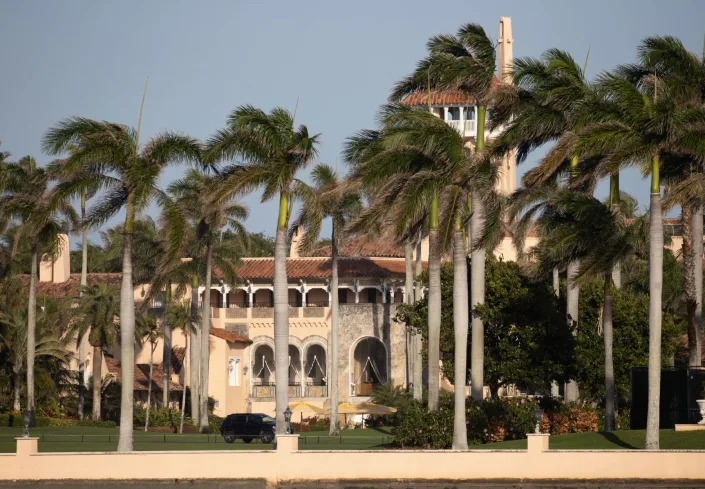Russia’s Trump Raid Tantrum Is a Spectacle You Don’t Want to Miss
Julia Davis
Tue, August 9, 2022

Photo Illustration by Elizabeth Brockway/The Daily Beast/Getty
The FBI raid on former U.S. President Donald J. Trump’s Mar-a-Lago residence in Florida triggered shockwaves across Russia, with outraged Kremlin propagandists rushing to defend their favorite American president and going so far as to predict that the raid will eventually spark a civil war in the United States.
When Trump lost the last presidential election to Joe Biden, experts and pundits in Moscow worried out loud that his prosecution for a bevy of potential offenses is imminent. They even contemplated offering their beloved “Trumpushka” asylum in Russia. As time went by, Putin’s mouthpieces became convinced that Trump was in the clear, and their fears subsided.
On Monday’s broadcast of The Evening With Vladimir Solovyov, the host and his panelists praised the participants of the Conservative Political Action Conference (CPAC) and expressed their admiration for Trump and his allies. The same day, appearing on state TV program 60 Minutes, military expert Igor Korotchenko openly called for Russia to support Trump’s candidacy in the 2024 elections.
News of the raid landed in Moscow with a thud, as angry propagandists embellished the search with made-up details, claiming that “one hundred FBI agents” and hordes of police dogs rummaged through Mar-a-Lago. On Tuesday’s broadcast of 60 Minutes, Korotchenko angrily condemned the raid: “There is a straight-up witch hunt happening in America. Trump, as the most popular politician in the United States—who has every chance of prevailing in the upcoming presidential election—was chosen as such a witch,” he raged. “They won’t just be vilifying him, they will be strangling him. These raids, involving dozens of FBI officers and police dogs—this is worse than McCarthyism, my friends! This is a symbol of inordinate despotism.”
Russian Media Wants Moscow to Grant Asylum to Trump
In the days preceding the raid, the host of 60 Minutes, Evgeny Popov, who is also a deputy of Russia’s State Duma, repeatedly referred to Trump as Russia’s “friend,” “protégé”, and a favored candidate, but cautiously added that Moscow is yet to decide on who to support in the upcoming U.S. elections. On Tuesday, Popov said: “As soon as Donald Trump complained that Biden was the worst president in the history of the United States, which is fast becoming a third world country, there was a knock on Donald’s door: “Knock-knock, this is the FBI!” More than one hundred agents stormed in and searched Trump’s Florida residence, Mar-a-Lago.” Popov joked that the agents were said to have found a couple of matryoshka, Putin’s portrait, a pioneer scarf, two icons, a parachute, and a chained bear with balalaika.
Without a hint of irony, the state TV host described the search of the former president’s home as a symptom of political persecution of dissidents in the United States. “Dozens of agents ransacked every office, went through every box, and took every document that was of interest to them. It is thought that the FBI was interested in the Top Secret documents supposedly taken by the ex-president from the White House... Biden, with his dictatorial tendencies, repressions, and persecution of dissidents, is turning America into Ukraine. He already did that, since the opposition is being persecuted by authorities,” Popov said. He fantasized that as the result of the raid, Florida would split from the United States and its new constitution would feature Trump’s assertion that there are only two genders: male and female.
Decorated Kremlin propagandist Vladimir Solovyov started Tuesday’s broadcast of his radio program, Full Contact With Vladimir Solovyov, by bringing up the raid of Trump’s Florida digs. He brought on state TV correspondent Valentin Bogdanov, reporting from New York City. “You couldn’t say we didn’t anticipate this turn of events. Machinery, meant to squeeze Trump out of political life, has been activated... They want to deprive him of an opportunity to participate in the upcoming presidential election... All of this is designed to create a nasty aura, to make Trump more toxic.”
Summing up the potential penalties for the suspected removal of top secret government documents, Bogdanov said they weren’t all that bad and were limited to a three-year prison term or a fine. He added: “The scariest consequence is that a person convicted for such a crime can’t be a candidate in the presidential election. Bingo! That’s what his opponents want: to deprive him of the opportunity to take part in this race.”
Assuming that Trump would be knocked out of the upcoming presidential election, Bogdanov speculated that Florida governor Ron DeSantis—whom he described as “Number Two” in the GOP—could easily defeat Joe Biden.
Solovyov asked: “Could this be the beginning of a civil war?” He ominously opined: “This is totally unprecedented, I don’t remember anything like this in American history. If Trump calls on his supporters to come out—and half the states are led by Trump’s allies—there’ll be hell to pay.”
Bogdanov replied: “The civil war is already underway in the United States. For now, this is a cold civil war, but it keeps heating up.”
Fox News Is Having a Nuclear Meltdown
Over the Feds Raiding Mar-a-Lago
Ryan Bort
Mon, August 8, 2022
The FBI raided Donald Trump’s estate in Palm Beach on Monday, reportedly in search of any leftover classified documents he may have taken from the White House. The search began in the morning, but didn’t make the news until later, when the former president announced the “prosecutorial misconduct” just in time for Fox News’ primetime propaganda lineup to have a collective conniption over the Justice Department spending the day at Mar-a-Lago.
Jesse Watters set the tone early, ranting about how the Justice Department is giving Democrats a pass while going after poor, innocent Trump. Dana Loesch, the former National Rifle Association spokesperson, agreed. “There’s more evidence to implicate the Bidens than there is for the Trumps,” she claimed. “Everything they’ve accused the former first family of, it seems like it’s the Bidens that have done it.” (Loesch did not point to anything indicating Biden absconded from the White House with classified documents.)
More from Rolling Stone
IRS Must Hand Trump's Tax Returns Over to House Committee, Court Rules
Trump and Republicans Are Already Trying to Cash in on the Mar-a-Lago Raid
Inside Trump's Frantic Hunt for 'Killer' Criminal Defense Attorneys
The other common right-wing reaction to the raid suggested FBI needs a complete overhaul, starting at the top. “I don’t see how this guy has any credibility whatsoever,” Watters said of FBI Director Chris Wray. “He’s got to go.” (Watters did not seem to care that Wray was appointed not by the radical Democrats, but by Trump himself.)
Will Cain, who filled in for Tucker Carlson on Tucker Carlson Tonight, cast the raid in historical terms, wondering if it marked a “seminal moment” that “generations will look back on and ask, ‘Was this a moment we broke apart or we were able to come together?'”
Cain then asked whether there was an “evidentiary” or “legal” basis for the raid, or if it was simply a “partisan witch hunt.” (Cain mentioned that Trump allegedly took classified documents from the White House to Mar-a-Lago almost immediately before wondering if there was any basis for the search.)
Fox News was even able to wrangle a few members of Trump’s family to comment on the raid. Lara Trump said she didn’t see any issue with the former president potentially stealing classified documents from the White House. “My father-in-law, as anybody knows who’s been around him a lot, loves to save things like newspaper clippings, magazine clippings, photographs — documents that he had every authority to take from the White House,” she explained to Cain before transitioning into a rant about Hillary Clinton’s emails.
Her husband, Trump’s son Eric, made the same point to Sean Hannity an hour later. “My father always kept press clippings, newspaper articles, pictures, notes from us,” he said. “He had boxes. He moved out of the White House. He’s very collaborative. If you want to search for anything, come right ahead. It was an open-door policy, and all of a sudden 30 agents descend upon Mar-a-Lago?”
The Trumps likening classified documents to press clippings may have been amusing, but others suggested a more terrifying response. Russ Voght of the Center for Renewing America told Laura Ingraham that Republicans need to “dismantle the FBI into a thousand bits” and “prepare for a church style commission next year if given a Republican majority.”
“When we get power back, it’s time to hold everyone accountable,” Ingraham added. “The military leadership, the civilian leadership, the civil service, those in Congress who have abused their power — all of them have to be held accountable.”
The raid has stirred up such a frenzy on Fox News and throughout the right-wing media ecosystem because it gives conservatives an excuse to do the thing they love to do more than anything else in the world, outside of maybe making it harder for people to get insulin: Paint themselves as victims. Trump’s entire ethos revolves around the idea that he, a white man born into wealth and handed every advantage in life, has been wronged by society. Republicans have gladly taken after their leader — and as Fox News’ primetime programming on Monday made clear, they’re willing to use the Justice Department executing a search warrant on a man suspected of committing a crime as the latest piece of evidence that conservatives are under assault by an unjust system.
“Make no mistake,” Hannity warned, “if you are associated with Donald Trump in any way, you better cross all your I’s and dot all your T’s, because they’re coming for you with the full force of the federal government.”






